
Michael I was the ruler of the Polish–Lithuanian Commonwealth as King of Poland and Grand Duke of Lithuania from 29 September 1669 until his death in 1673.

This is a list of historical regions in present-day Ukraine.
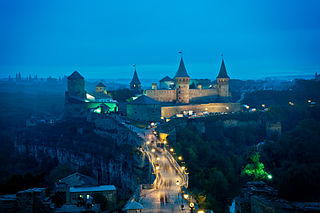
Podolia or Podilia is a historic region in Eastern Europe, located in the west-central and south-western parts of Ukraine and in northeastern Moldova.

The haidamakas, also haidamaky or haidamaks were Ukrainian paramilitary outfits composed of commoners, and impoverished noblemen in the eastern part of the Polish–Lithuanian Commonwealth. They were formed in reaction to the Commonwealth's actions that were directed to reconstitute its orders on territory of right-bank Ukraine, which was secured following ratification of the Treaty of Perpetual Peace with the Tsardom of Russia in 1710.

The Khmelnytsky Uprising, also known as the Cossack–Polish War, or the Khmelnytsky insurrection, was a Cossack rebellion that took place between 1648 and 1657 in the eastern territories of the Polish–Lithuanian Commonwealth, which led to the creation of a Cossack Hetmanate in Ukraine. Under the command of hetman Bohdan Khmelnytsky, the Zaporozhian Cossacks, allied with the Crimean Tatars and local Ukrainian peasantry, fought against Polish domination and Commonwealth's forces. The insurgency was accompanied by mass atrocities committed by Cossacks against the civilian population, especially against the Roman Catholic and Ruthenian Uniate clergy and the Jews, as well as savage reprisals by Jeremi Wiśniowiecki, the voivode of the Ruthenian Voivodeship.

Hetman of Zaporizhian Cossacks is a historical term that has multiple meanings.
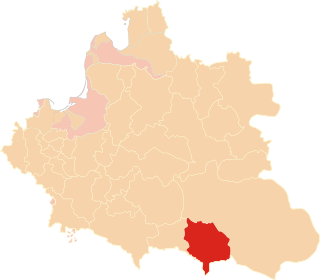
The Bracław Voivodeship was a unit of administrative division of the Polish–Lithuanian Commonwealth. Created in 1566 as part of the Grand Duchy of Lithuania, it was passed to the Crown of Poland in 1569 following the Union of Lublin. After partitions of Poland in 1793 the voivodeship was taken by the Russian Empire and replaced with the Bratslav Viceroyalty.

Chyhyryn is a city in Cherkasy Raion, Cherkasy Oblast, central Ukraine. From 1648 to 1669, the city served as the residence of the hetman of the Zaporizhian Host. After a forced relocation of the Ruthenian Orthodox metropolitan see from Kyiv in 1658, it became a full-fledged capital of the Cossack Hetmanate. Chyhyryn also became a traditional place for the appointment to the office of the hetman of the Zaporizhian Host. It hosts the administration of Chyhyryn urban hromada, one of the hromadas of Ukraine. Population: 8,539.
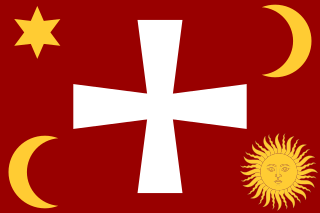
Registered Cossacks comprised special Cossack units of the Polish–Lithuanian Commonwealth army in the 16th and 17th centuries.
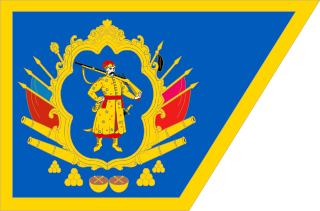
The Cossack Hetmanate, officially the Zaporozhian Host or Army of Zaporozhia, is a historical term for the 17th-18th centuries Ukrainian Cossack state located in central Ukraine. It existed between 1649 and 1764, although its administrative-judicial system persisted until 1782.

The Nalyvaiko Uprising was a Cossack rebellion against the Polish–Lithuanian Commonwealth. Headed by Severyn Nalyvaiko, it lasted from 1594 to 1596. The second in a series of Cossack uprisings, the conflict was ultimately won by the Crown of Poland, but two years of warfare and scorched-earth tactics employed by both sides left much of right-bank Ukraine in ruins.

The Ruin is a historical term introduced by the Cossack chronicle writer Samiilo Velychko (1670–1728) for the political situation in Ukrainian history during the second half of the 17th century.

The Wild Fields is a historical term used in the Polish–Lithuanian documents of the 16th to 18th centuries to refer to the Pontic steppe in the territory of present-day Eastern and Southern Ukraine and Western Russia, north of the Black Sea and Azov Sea. It was the traditional name for the Black Sea steppes in the 16th and 17th centuries. In a narrow sense, it is the historical name for the demarcated and sparsely populated Black Sea steppes between the middle and lower reaches of the Dniester in the west, the lower reaches of the Don and the Siverskyi Donets in the east, from the left tributary of the Dnipro — Samara, and the upper reaches of the Southern Bug — Syniukha and Ingul in the north, to the Black and Azov Seas and Crimea in the south.

Krzemieniec Lyceum ; sometimes referred to as "the Volhynian Athens" and "Czacki's School") was a renowned Polish secondary school which existed 1805-31 and later, in the Interbellum, in 1922-39 in Krzemieniec.

The Volhynia Governorate, Volhynian Governorate or Volyn Governorate was a province (guberniya) of the Southwestern Krai of the Russian Empire. It consisted of an area of 71,736 square kilometres (27,697 sq mi) and a population of 2,989,482 inhabitants. The governorate bordered the Grodno and Minsk Governorates to the north, the Kiev Governorate to the east, the Podolia Governorate to the south, the Lublin and Siedlce Governorates, and after 1912, the Kholm Governorate and Austria to the west. The administrative centre was Zhitomir, until 1804, its administrative centre was located in Novograd-Volynsky. It corresponded to most of Volyn, Rivne and Zhytomyr Oblasts of Ukraine and some parts of Brest and Gomel Regions of Belarus.

Kiev Governorate was an administrative division of the Russian Empire from 1796 to 1919 and the Ukrainian Soviet Socialist Republic from 1919 to 1925. It was formed as a governorate in the right-bank Ukraine region after a division of the Kiev Viceroyalty into the Kiev and the Little Russia Governorates in 1796, with its administrative centre in Kiev. By the early 20th century, it consisted of 12 uyezds, 12 cities, 111 miasteczkos and 7344 other settlements. After the October Revolution, it became part of the administrative division of the Ukrainian SSR. In 1923 it was divided into several okrugs and on 6 June 1925 it was abolished by the Soviet administrative reforms.

The early modern era of Polish history follows the Late Middle Ages. Historians use the term early modern to refer to the period beginning in approximately 1500 AD and lasting until around 1800.

The history of the Polish–Lithuanian Commonwealth (1648–1764) covers a period in the history of Poland and the Grand Duchy of Lithuania, from the time their joint state became the theater of wars and invasions fought on a great scale in the middle of the 17th century, to the time just before the election of Stanisław August Poniatowski, the last king of the Polish–Lithuanian Commonwealth.
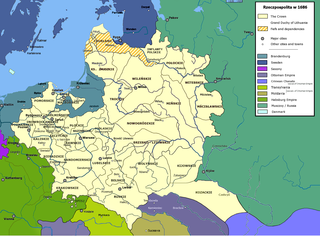
Ottoman Ukraine, Khan Ukraine, Hanshchyna is a historical term for right-bank Ukraine, also known by its Turkic name Yedisan. The first recorded use of the term Khanska Ukraina are traced to 1737 when the Russian secret-agent Lupul urged Empress Anna of Russia to attack Ottoman Ukraine.
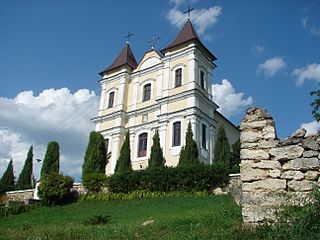
The history of Polish people in Transnistria goes back centuries when the communities along the lower Dniester river were part of Podolia in the Polish–Lithuanian Commonwealth and later the Russian Empire.
























